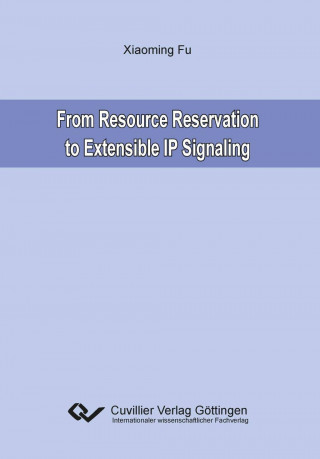
Kód: 12828513
From Resource Reservation to Extensible IP Signaling
Autor Xiaoming Fu
In recent years, the tremendous growth of the Internet and the increasing demand of user applications have resulted in a number of architectural changes to the Internet infrastructure. By its original, the Internet based on the pa ... celý popis
- Jazyk:
 Angličtina
Angličtina - Väzba: Brožovaná
- Počet strán: 172
Nakladateľ: Cuvillier Verlag, 2014
- Viac informácií o knihe

Mohlo by sa vám tiež páčiť
-

You Can't Touch My Hair
16.48 € -5 % -

Myth and the Human Sciences
90.74 € -

Fast Like a Girl
28.36 € -

Bugün Farkli Düsünüyorum
15.97 € -

Comment Faire L'Amour Toute La Nuit
26.11 € -

Antiterrordateigesetz
86.95 € -

Entwicklung Durch Handel?
49.57 €
Darujte túto knihu ešte dnes
- Objednajte knihu a vyberte Zaslať ako darček.
- Obratom obdržíte darovací poukaz na knihu, ktorý môžete ihneď odovzdať obdarovanému.
- Knihu zašleme na adresu obdarovaného, o nič sa nestaráte.
Viac informácií o knihe From Resource Reservation to Extensible IP Signaling
Nákupom získate 81 bodov
 Anotácia knihy
Anotácia knihy
In recent years, the tremendous growth of the Internet and the increasing demand of user applications have resulted in a number of architectural changes to the Internet infrastructure. By its original, the Internet based on the packet-switched technology has been designed for delivering packets in a best effort fashion: the end systems do not need to inform the network prior to transmitting their IP packets, whole routers simply perform routing and forwarding of these packets without distinguishing from each other. However, this design has been challenged due to the new requirements which have been dramatically different from over 30 years ago. For example, to realize the bandwidth and connectivity on demand for the service providers, a signaling protocol seems to be critical. Signaling is not a new topic. In the telecommunication industry, signaling is common and can be dated back to when circuit switches first replaced human telephone operators. Even the modern Signaling System No. 7 (SS7) [187] began its development in the mid 1970's, based on the idea that relies on a separate control element (i.e., the SS6 signal switches) to signal to other control element to set up, manage and release voice trunk lines required to make a call. Based on the signaling standard for ISDN [8], ITU-T standardized a Q.2931 signaling protocol [9] which allows ATM nodes to exchange control of information, request the use of network resources, or negotiate for the use of circuit parameters, for instance, mapping between an input set and an output set of virtual circuit parameters, for instance, mapping between an input set and an output set of virtual circuit identifiers (VCIs) and virtual path identifiers (VPIs). Essentially, signaling protocols manages states in network nodes. They generally reflect some requirements of an end-to-end session/call to the traverses nodes. Thus, they need to be maintained properly, especially when network "conditions" change (e.g., some link or node fails, or the traversing route changes). The task of a signaling protocol involves establishing, maintaining and removing network control states, traversing from one end system to another through the network. Hence, the concept of signaling protocol discussed in this book mainly targets at network control state singnaling.
 Parametre knihy
Parametre knihy
32.87 €
- Celý názov: From Resource Reservation to Extensible IP Signaling
- Autor: Xiaoming Fu
- Jazyk:
 Angličtina
Angličtina - Väzba: Brožovaná
- Počet strán: 172
- EAN: 9783954046010
- ISBN: 3954046016
- ID: 12828513
- Nakladateľ: Cuvillier Verlag
- Hmotnosť: 231 g
- Rozmery: 210 × 148 × 9 mm
- Dátum vydania: 07. March 2014
Obľúbené z iného súdka
-

Berserk Deluxe Volume 1
48.34 € -5 % -

Haunting Adeline
30.72 € -

Berserk Deluxe Volume 3
51.72 € -

Berserk Deluxe Volume 2
52.95 € -

LEGO Star Wars Visual Dictionary Updated Edition
23.34 € -9 % -

Atomic Habits
15.97 € -15 % -

Powerless
11.97 € -8 % -

Chainsaw Man, Vol. 15
10.44 € -23 % -

Harry Potter and the Prisoner of Azkaban (Minalima Edition)
41.68 € -

House of Leaves
23.45 € -22 % -

Berserk Deluxe Volume 5
52.33 € -

Hunting Adeline
31.84 € -

Cry Baby Coloring Book
11.46 € -

Iron Flame
16.28 € -19 % -

White Nights
3.57 € -24 % -

The Official Stardew Valley Cookbook
26.01 € -9 % -

JUJUTSU KAISEN V22
12.49 € -7 % -

Gravity Falls Journal 3
20.68 € -5 % -

Heaven Official's Blessing: Tian Guan Ci Fu (Novel) Vol. 2
22.11 € -

Twisted Lies
9.82 € -24 % -

Berserk Deluxe Volume 4
48.23 € -5 % -

Surrounded by Idiots
10.74 € -11 % -

Berserk Deluxe Volume 6
51.20 € -

Dune Messiah
9 € -21 % -

The 48 Laws of Power
26.11 € -4 % -

Twisted Love
9.82 € -24 % -

Bungo Stray Dogs, Vol. 8 (light novel)
16.58 € -

Fourth Wing
10.23 € -15 % -

Dune
9.72 € -19 % -

Twisted Games
9.82 € -24 % -

Heaven Official's Blessing: Tian Guan Ci Fu (Novel) Vol. 1
20.68 € -5 % -

A Little Life
17.50 € -

CHAINSAW MAN V14
11.26 € -14 % -

Court of Thorns and Roses Paperback Box Set (5 books)
54.58 € -13 % -

Berserk Deluxe Volume 10
58.78 € -

King of Sloth
10.74 € -17 % -

Raising Mentally Strong Kids: How to Combine the Power of Neuroscience with Love and Logic to Grow Confident, Kind, Responsible, and Resilient Child
29.90 € -

Vagabond (VIZBIG Edition), Vol. 1
24.47 € -5 % -

48 Laws Of Power
18.12 € -10 % -

Court of Mist and Fury
9.41 € -21 % -

Court of Thorns and Roses
9.31 € -20 % -

The Husky and His White Cat Shizun: Erha He Ta de Bai Mao Shizun (Novel) Vol. 5
20.17 € -5 % -

No Longer Human
16.58 € -

Heaven Official's Blessing: Tian Guan Ci Fu Vol. 4
18.63 € -10 % -

Twisted Series 4-Book Boxed Set
38.71 € -23 % -

Throne of Glass Box Set (Paperback)
94.94 € -16 % -

Powerful
11.36 € -13 % -

Dead Poets Society
10.54 € -

A Court of Silver Flames
10.13 € -22 %
Osobný odber Bratislava a 2642 dalších
Copyright ©2008-24 najlacnejsie-knihy.sk Všetky práva vyhradenéSúkromieCookies



 21 miliónov titulov
21 miliónov titulov Vrátenie do mesiaca
Vrátenie do mesiaca 02/210 210 99 (8-15.30h)
02/210 210 99 (8-15.30h)